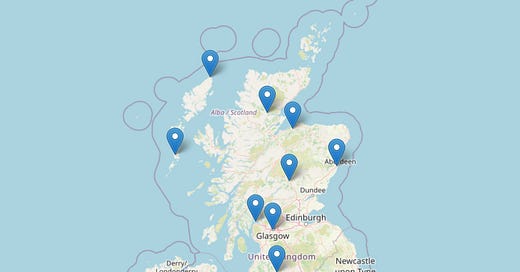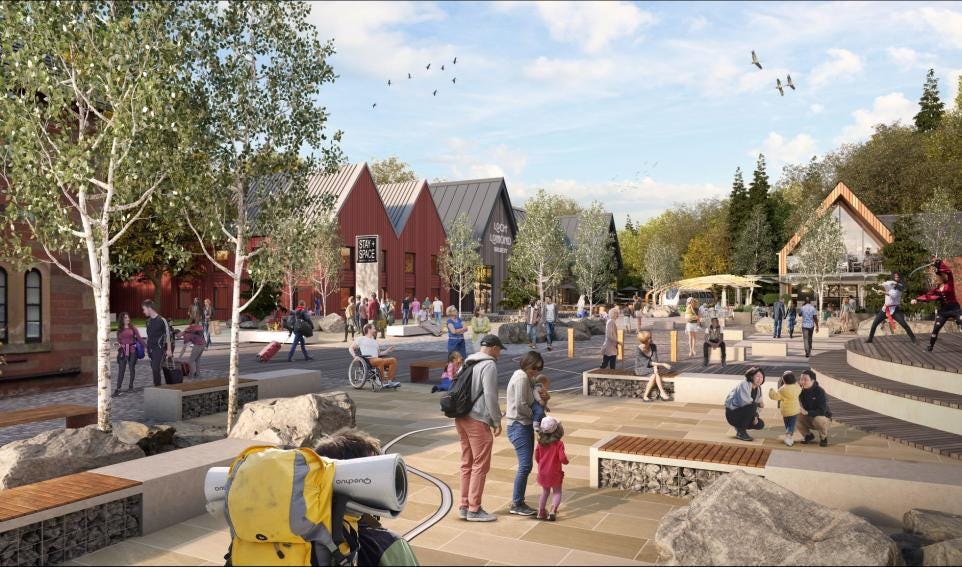📢Introducing: The Power Shift – a collaborative investigation into the impact of Scotland’s green energy boom
We want to hear from you. How is Scotland’s green energy transition impacting you and your community? Plus: stories on Flamingoland, Shaetlan – Shetland’s native tongue, and impact of rent cap removal
The Power Shift is a major new collaborative journalism project from the Scottish Beacon which will be investigating how Scotland’s green energy transition is reshaping land, communities, and power dynamics across the country – with support from the Tenacious Journalism Awards.
The subject of the green transition has been politicised, and even weaponised. Too often this means that coverage of this topic has been portrayed as black and white. We want to stay in the realms of the grey, embracing complexity and covering nuance. We will explore what’s working as well as what’s not, and what communities can learn from one another. We will also cover how the renewable energy revolution can be driven by local communities themselves.
This is a process that is happening now – and at scale. It’s a process that has huge potential but has also sparked debates around ownership and local democracy. The renewables revolution is an essential part of the fight against climate catastrophe and has the potential to bring jobs, and clean affordable energy to communities across Scotland. But the revolution also throws up big questions:
Who benefits from huge infrastructure projects? What’s in it for local people? Who gets to decide how a community benefits? How does the renewables boom interplay with issues of land-ownership, crofting and often fragile ecosystems? How can we protect common land and precious environmental assets? When will our energy bills come down? What would constitute real benefits for affected communities? Could community shared ownership be the answer? And how will this affect community owned energy projects?
Ultimately, the question is: what is energy for?
Communities face huge, private, foreign-owned companies that are often remote and unresponsive. Shetland already hosts the SSE Renewables owned Viking Energy wind farm, at 443MW one of the UK’s largest onshore wind farms. Yet the islands have one of the highest fuel poverty rates in the country, meaning that to heat their homes people generally spend twice as much as the UK average. The same pattern can be found in communities across the country.
This topic has also the subject of ongoing consultation by the Scottish Government – who have been seeking “ ways to improve how communities will receive additional benefits from renewable energy developments”. The UK Government has recently set out a white paper “seeking views on potential mandatory community benefits for low carbon energy infrastructure, and shared ownership schemes”.
The Power Shift is an innovative collaboration between independently owned, community-based newspapers and magazines to tell the story from the ground up. Our partners on this project span the length of Scotland from the Outer Hebrides to Galloway. They cover urban, rural and island populations. They include: Kyle Chronicle; Shetland News; Bylines Scotland; Glenkens Gazette; Forres Local; Am Paipear; The Bellman, Greater Govanhill, Fios; and Lochside Press.
The picture across Scotland is mixed, with some communities already in receipt of huge resource from community renewables, while others are suffering at the behest of a planning system which seems opaque at best. By working together, we are able to notice patterns across different locations to create national stories about how the bigger picture is playing out across Scotland.
One of the challenges facing communities is how to organise to reap the benefit of a renewables revolution that we are not in control of. How do you create a democratic forum within small rural communities that can come to decisions about appropriate use and also redistribute income and community benefits with transparency and impact?
Over the next six months we’ll be working collaboratively on an investigation about the positive and negative impacts of Scotland’s next energy boom – in a process of cross-community learning and knowledge sharing. We’ll also be releasing an accompanying podcast. Together, we’ll be investigating best (and worst) practice as well as building a network of experts to feed-in to this national conversation about how the Power Shift can bring maximum benefit to Scotland’s communities.
Have your say
We also want to hear from you. How has the green transition played a part in your community? Please take a moment to share your stories via the survey link below.
Tell us how the renewables industry expansion has impacted your community
Other stories from our website
Study finds community energy generates 100x more wealth than corporate counterparts
Community-owned energy projects are punching well above their weight and returning vastly more wealth to local people than their privately-owned counterparts. So why make do with crumbs from the corporate table?
Giving Shaetlan – Shetland’s native tongue – the respect it deserves
New book highly praised by linguists from around the world establishes Shaetlan as a language…
Rent caps are gone: how can tenants fight back?
With Scotland’s rent cap scrapped last month, residents run the risk of being hit with unaffordable rent hikes…
Foodbank manager ‘very concerned’ by number of people requiring support
Nearly 1,100 food parcels have been distributed in Shetland over the last year, Shetland Foodbank…
Age Scotland launches Act Now, Age Better campaign
With an ageing population, people are living longer but not necessarily living longer in good health…
More from our partners
The Lochside Press: A new motion has been put to the Scottish Parliament in an attempt to overturn the approval of the construction of a new Flamingo Land at Loch Lomond
Greater Govanhill: Across Glasgow, people are coming together to welcome refugee families into their communities through a powerful grassroots approach called community sponsorship
The Edinburgh Reporter: Midlothian has no current plans to introduce a drugs safer consumption room amid concern about ‘community disquiet’ surrounding Scotland’s first one in Glasgow
Migrant Women Press: The labour exploitation of migrant care workers isn’t simply due to ‘rogue employers’, it’s etched into the fabric of the UK’s Immigration system
Midlothian View: New net zero report sets out path to cut carbon and costs for small firms & shows 51% of small firms say that sustainability is a high priority for their business
Forres Local: Moray Council has decided to ban mobile phone use in schools this August, aiming to reduce distractions and promote positive learning environments
The Bellman: A North East dance school on a mission to tackle rural isolation and promote equal opportunities recieved national acclaim at the Scottish Dance Awards 2025
Shetland News: Visitors spent around £50 million in total when in Shetland last year, it has been estimated
The Orkney News: A trickle of humanitarian aid is now starting to get into Gaza. For over 11 weeks no humanitarian aid entered the Gaza Strip due to the siege imposed by the Israeli authorities
Elsewhere in local news…
‘From Ukraine to the UK: Why Local Journalism Matters’
In a piece for the Public Interest News Foundation, Olga Rudenko, editor-in-chief of the Kyiv Independent, reflects on the vital role of local journalism in times of crisis. Drawing on her experience in Ukraine, she describes how independent, community-rooted media became a lifeline during the war, offering trusted information when it was needed most.
Rudenko recounts the Kyiv Independent’s launch in late 2021, just before Russia’s full-scale invasion. Despite scarce resources, the outlet now reaches a global audience and is supported by over 17,000 readers—highlighting the resilience and impact of local journalism.
Her reflections resonate in the UK, where community reporters have helped document and support Ukrainian refugee integration through local stories and initiatives. As Rudenko notes, “In wartime, people need news more than ever.”
‘These Newsrooms Are Trying to Boost Trust Through Transparency. Is It Working?’
A new report from the Reuters Institute examines how newsrooms around the world are focussing on transparency as a way to rebuild trust with their audiences. Researchers found that while there’s no universal fix to the lack of trust in the media, efforts to communicate more openly about editorial practices, funding, and ethical standards can make a difference, particularly when paired with consistent, accurate reporting.
The study looks at 12 news organisations in the UK, US, Brazil and India. It shows that newsroom transparency tends to be most effective when combined with other strategies, such as building closer relationships with audiences, maintaining editorial independence and reflecting community diversity. However, results vary by region and audience; what works in London may fall flat in São Paulo or Delhi.
Ultimately, the research suggests that transparency can help foster trust but only as part of a broader, more sustained effort to meet the needs and expectations of different communities.









This is a terrific read. Well done to all involved. A welcome and vast difference to the scant efforts on BBC website for local Scottish news.